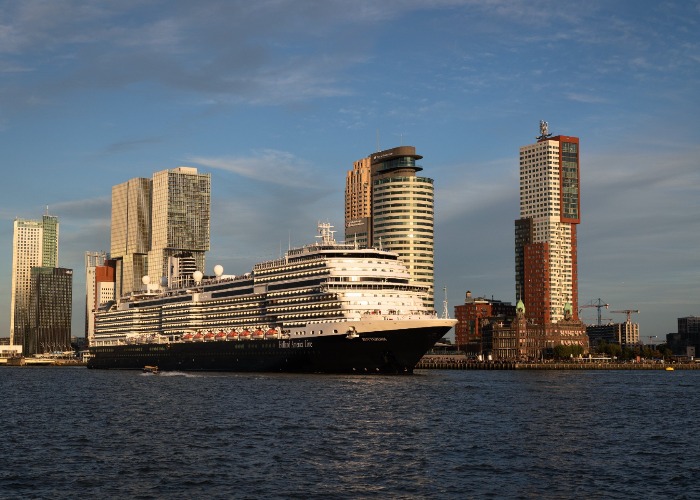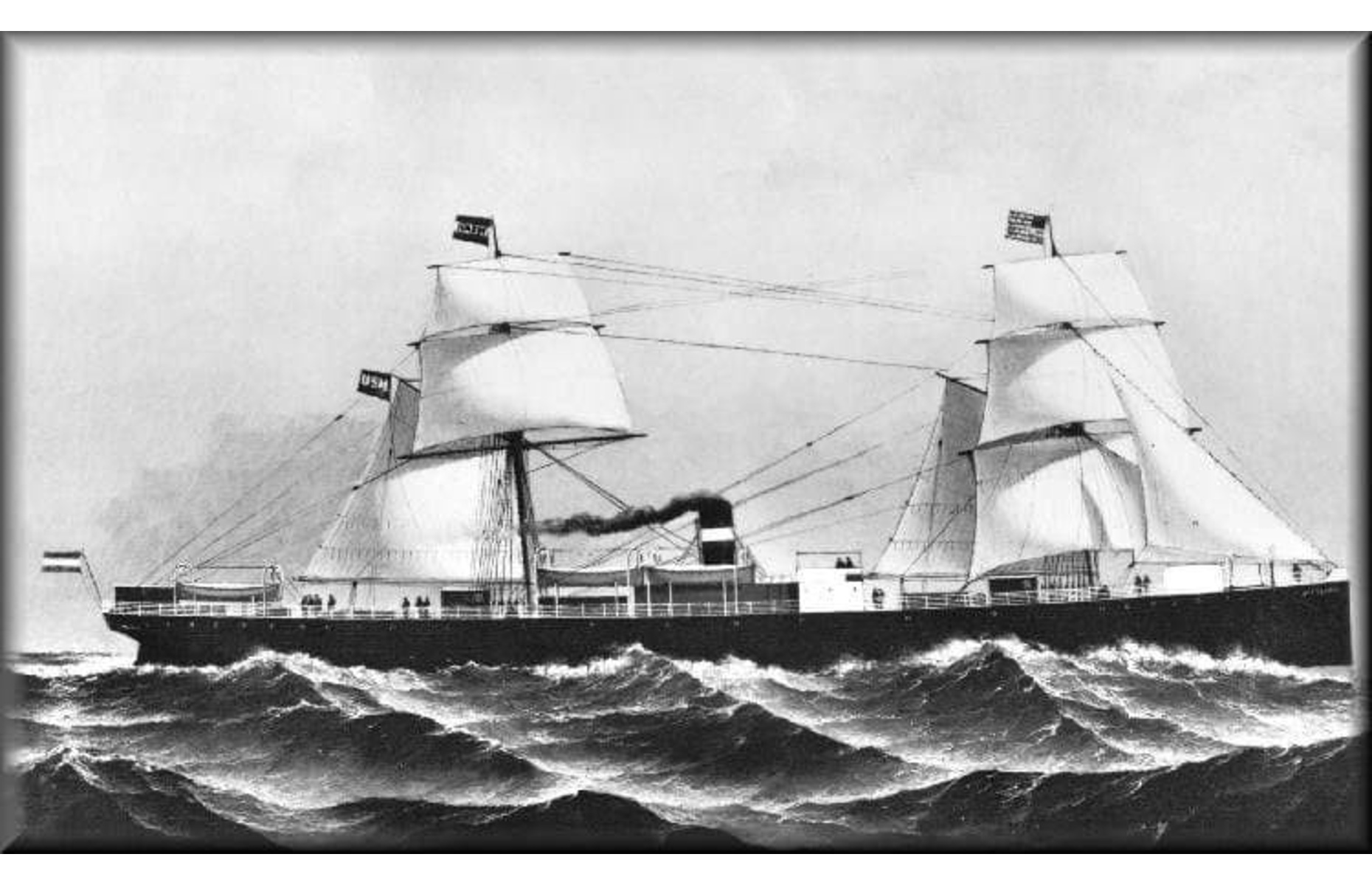
MS Rotterdam has been transporting passengers across the Atlantic since 1873, and the cruise liner is celebrating its 150th anniversary with a series of special commemorative crossings. Jo Kessel hops onboard.
A sea of faces gaze up at the structure in front of them, a 1,684-ton hulk of a ship that, they hope, will take them to a whole new life. There are solo travellers, couples and parents with children clinging to their legs. They’re all waiting here, on the quay in Rotterdam, to board for the journey of a lifetime, and they all share the same dream: America.
The year is 1873, and the ship is the SS Rotterdam. Hours later, she would depart on a transatlantic voyage from the Netherlands to New York. It was the inaugural sailing for Rotterdam, the first ship launched by cruise line Holland America.

A ship with history
Rotterdam has been pretty successful at reinventing herself, from taking people to their new lives to transporting soldiers during wartime and eventually becoming the upmarket cruise line it is today. Rotterdam IV, christened in 1908 and considered one of the most opulent vessels of her time, was graced with two Tiffany glass domes. Rotterdam V is a floating hotel in Rotterdam’s port.
READ MORE: Secrets of the Titanic: life onboard the world's most famous ship
To mark next April’s 150th anniversary of the inaugural sailing, Holland America has scheduled a year of commemorative sailings. The first is a crossing recreating that very first voyage, following the same route from Rotterdam to New York via Le Havre and Plymouth, which is where I hop onboard.
The ship I’m on is Rotterdam VII, a direct descendant of that very first vessel – though her latest incarnation is rather different. Back then, travellers paid $10 (about £8.50) a pop to travel in steerage, and slept in narrow bunks stacked up in cramped dormitories.
READ MORE: The world's best new cruise destinations
Onboard entertainment
As the ship pulls away from Plymouth, I’m mindful that a transatlantic crossing is not the same as a regular cruise. There will be no daily port stops to get off and explore. Indeed, for the next seven days nobody will be getting off at all.
Unlike 150 years ago, there are plenty of organised activities to enjoy and the next day begins with a stretch class in the yoga studio followed by walking three miles (4.8km, or 10 laps) around the promenade deck. Next is a history talk, where we’re told how steerage passengers were only allowed out for an hour a day, to stretch their legs. My morning has, of course, been very different, and I feel extremely priviliged.
Blast from the past
The main dining room serves dishes from the original menu (think chopped sirloin steak with brown mustard sauce, and Dutch apple pie) and there’s what’s billed as ‘Classic Cruise Games’. I team up with two Dutch passengers and an American for a take on an egg and spoon race – the spoon’s held in one’s mouth, while the ‘egg’ is a ping pong ball.
It’s good, wholesome fun, and even better when our team somehow wins. We celebrate the victory at the ship’s throwback happy hour, where drinks from 150 years ago are served at prices that are also straight out of the 19th century. Mine’s a G&T.
"How much is it?" I ask the barman.
"That's 50 cents."
Am I hearing correctly? It's the cheapest drink I've ever bought and it's generous too, served in a fish-bowl cocktail glass, garnished with cucumber, peppercorns and anise. It's sensational.
READ MORE: The coolest features onboard cruise ships
Michelin-starred meals
The days fall into a rhythm, filled with exercise classes, lectures, walks, more classic games (think Simon Says and cornhole) and soaks in the outdoor hot tubs. The only thing that changes is the sea. For 48 hours the Atlantic becomes a frothing monster of towering waves. Our ship has stabilisers; its predecessor would have rolled mercilessly.
When the sea calms – it becomes flat as a lake – I splash out on a couple of dinners in the ship’s speciality restaurants. One’s in the Pinnacle Grill, where the beef tenderloin with lobster dumplings is exceptional, and the second is a pop-up of three Michelin star Dutch restaurant De Librije. Everything is lip-smacking, from the Fabergé-inspired egg filled with caviar to the crab bisque. I don’t want the meal to end.
Following in family footsteps
Many passengers have chosen this year to sail because of a personal connection with the liner. I meet Fred Piellusch, from Florida. He explains how his grandparents fled Germany on a Holland America ship in 1912, and how he and his wife have now cruised with the liner 37 times. “We’ve loved every one those cruises,” he tells me. “Though we didn’t sail steerage...”
While I grow more excited as we near New York, one lady in my exercise class is bereft. “I love sea days,” she says.
I see her point. At sea you can admire wildlife – whales one morning, dolphins the next. And you can indulge in activities you might not have time for on land, like watching a poolside movie or having a Himalayan salt stone massage. I also find myself boogying the night away to a live band at the ship’s B.B King’s Blues Club.
READ MORE: The world's historic skyscrapers are older than you think
End of the line
Our symbolic arrival into New York requires a 5am wake-up. We sail past the Statue of Liberty, then historic Ellis Island – where immigrants were officially processed – before docking at a pier on Manhattan. Skyscrapers soar in the near distance, twinkling in the dark through a veil of fog. Before air travel, this is how everyone would have arrived – it’s like rewinding to a bygone era.
It’s only a 10-minute walk to Times Square, Central Park and Fifth Avenue. But it’s at New York’s newest viewpoint, The Edge – a 100-storey high viewing platform jutting from a skyscraper – that I appreciate how Holland America Line truly changed lives. The whole of Manhattan sprawls out below, punctuated by the Empire State Building.
The city’s giddying energy and possibilities are tangible as, perhaps, they might have been for those very first travellers who arrived here around 150 years ago.
A 13-day 150th anniversary transatlantic crossing from New York to Rotterdam (with stops in Dover and Plymouth) costs from £1,399pp, departing 6 April, 2023. Price includes full board, drinks, excursions, Wi-Fi and dinner in a speciality restaurant. See hollandamerica.com for more information.
READ MORE: Amazing facts about cruise ships you might not know
Lead image: the new MS Rotterdam sailing away from the port of Rotterdam on its first 150th anniversary voyage in October 2022 (Courtesy of Holland America Line)